


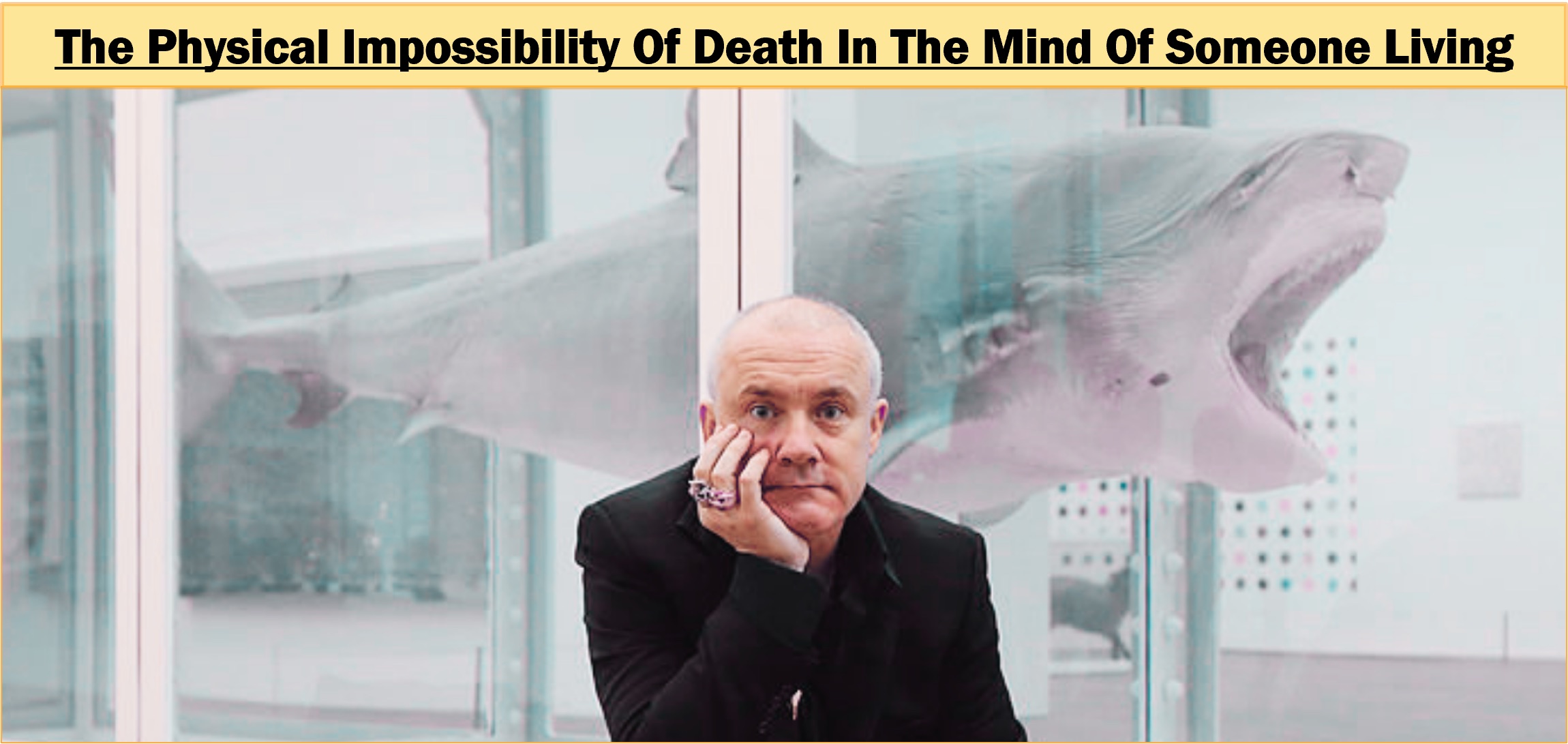
Damien Hirst is the best known of a group of British artists and one of his most iconic work is “The Physical Impossibility of Death in the Mind of Someone Living” – a 14-foot rare tiger shark immersed in formaldehyde in a vitrine weighing more than two tonnes. The shark was caught by a fisherman in Australia and he was paid US$6,000 of which US$4,000 for catching and US$2,000 for packing it in ice and shipping it to London. The British advertising magnate Charles Saatchi then bought his work for GBP50,000. In December 2004, Saatchi sold the work to Steve Cohen, the founder and principal of the uber hedge fund SAC Capital, for a staggering US$12 million. It is rumoured that creators of US drama series Billions were inspired by Steve Cohen when creating the character of Bobby Axelrod.
I always wonder: Is “The Physical Impossibility of Death in the Mind of Someone Living” really a bourgeois art or a proletarian taxidermy? I am sure most do not care. It is after all true that art tells you things you do not know you need to know until you know them.

Why this particular piece of art is a subject of much interest? To me, “The Physical Impossibility of Death in the Mind of Someone Living” is a symbol of money, ignorance and greed. Sharks have always been associated with ruthless greedy corporate raiders, as glamourised by Diana Henriques and her book “The White Sharks of Wall Street”. And this particular work of Hirst is an embodiment of excesses in the financial world.
Greed & Fear
One cannot separate ‘greed’ and ‘fear’ from financial markets including venture capital. Venture capitalists are creatures of fear and greed. Some investors succumb to the fear of missing out. Some are resolute in chase of significant benefits tied in with their investment. There is an ongoing debate about the current state of venture capital market. Some argue that there is too much exuberance in the market, driven by easy money and compounded by greed. Financial markets are awash with liquidity, thanks to accommodative monetary policies by the central banks across the globe. Prevailing low yield environment forces investors to look for higher yield assets and investment opportunities, and these factors explain the resurgence of financing deal value in the past year, mostly dominated by unicorns (>US$1 billion) and decacorns (>US$10 billion). As institutional investors chase for higher yielding investments and climb the risk ladder, more and more pooled money will be attracted to these late-stage venture capital investments.

 David Solomon of Goldman Sachs recently said in an interview at the Bloomberg New Economy Forum in Singapore that we are in one of those periods when greed has far outpaced fear. The question du jour is whether there is more upside : Is ‘greed’ dominating the market or is ‘fear’ peeping to take over?
David Solomon of Goldman Sachs recently said in an interview at the Bloomberg New Economy Forum in Singapore that we are in one of those periods when greed has far outpaced fear. The question du jour is whether there is more upside : Is ‘greed’ dominating the market or is ‘fear’ peeping to take over?
I am aware that recent market chatters revolve around ‘inflation’ and why the central banks need to tighten and how interest rates would go up. But I am of the view that valuation of financial assets including venture capital will remain supported at least in the short-term. Interest rates will remain low at least in part because of higher savings. There are more savings sloshing around, exacerbated by rising income inequality: a larger and larger slice of national income is going to the top decile of earners, and these wealthy few tend to save much of this income rather than spend it, and this directly pushes rates down. If those savings are invested, it would drive up asset prices further and yields would go down. Inequality is self-perpetuating, with the feedback loop running through low rates. Excess savings of the rich depress rates; low rates push asset prices up; the rich get richer still.
And if inflation persists, investors need to look for exposures and assets that have a better chance of outpacing inflation while also providing diversification. There is a clamour for hyper-growth companies (most of them are technology and tech-enabled) and emerging economies such as Southeast Asia. Presently investors have limited avenues to access these assets, and the politics of sentiment indicates that fear has not set in, and the economics law of supply and demand suggests there are still further upside (at least in the not too distant future).
It is worth to note that there is no physical impossibility about death, and like mortals, this exuberance may also die when the ‘fear’ snares the ‘greed’.
There is no shark like fear, there is no snare like folly and there is no torrent like greed.

Malaysian Healthcare: Public vs Private
There is an age-old debate over Public vs Private healthcare in Malaysia, which is better? Champions for private healthcare often paint public healthcare as inefficient, understaffed and overcrowded; while advocates for public healthcare are against the exorbitant fees charged by private healthcare provider. Which side of the debate do I stand?
Since I lack the finesse and poetic flair of my CIO in the art of writing, I shall begin my answer with my personal experience.
27 January 2021
"Yes, it is an emergency. He is in the operating theatre right now."
My heart sank as my father lay under the mercy of surgical knives 300km away from Kuala Lumpur. Knives held by strangers no less. As a professional overthinker (analyst), my mind immediately went into overdrive.
“What could it be? Carcinoma? Were there signs? Why did I not notice earlier? How can the doctor in the clinic not diagnose it immediately? Should we consider moving him to a Private hospital? What sort of answers should I seek from the doctor?”
Googling medical symptoms never bodes well for an overthinker. It exacerbates what the Buddhists call “prapañca1” – mental proliferation, or as I like to call it – down the rabbit hole and a speeding ticket. The journey back home was not mentally pleasant (foreshadowing Startup of the Month) and I should have complied with the speed limit.
The doctors from several private practices failed to determine the issue, while a young doctor in a public hospital pinpointed and ordered an emergency surgery immediately; saving his life. Does that mean public healthcare is better? Through my observations during the whole ordeal, I too opine that public hospitals/clinics are understaffed, overcrowded and underfunded.
However, are Private healthcare and extra funding the only answers to what is essentially a legacy issue? Just like how e-hailing start-ups reshaped the taxi industry, could the same happen for the Healthcare industry?
More importantly, what does the future holds for Malaysia’s Healthcare sector?
Malaysia’s Healthcare Industry Overview
According to Malaysia National Health Accounts Health Expenditure Report 1997-2019, Malaysians’ health expenditure has increased at a rapid pace. As Malaysia marches towards its goal as a high-income nation, its population will too transition into an ageing population; albeit less extreme compared to Japan.
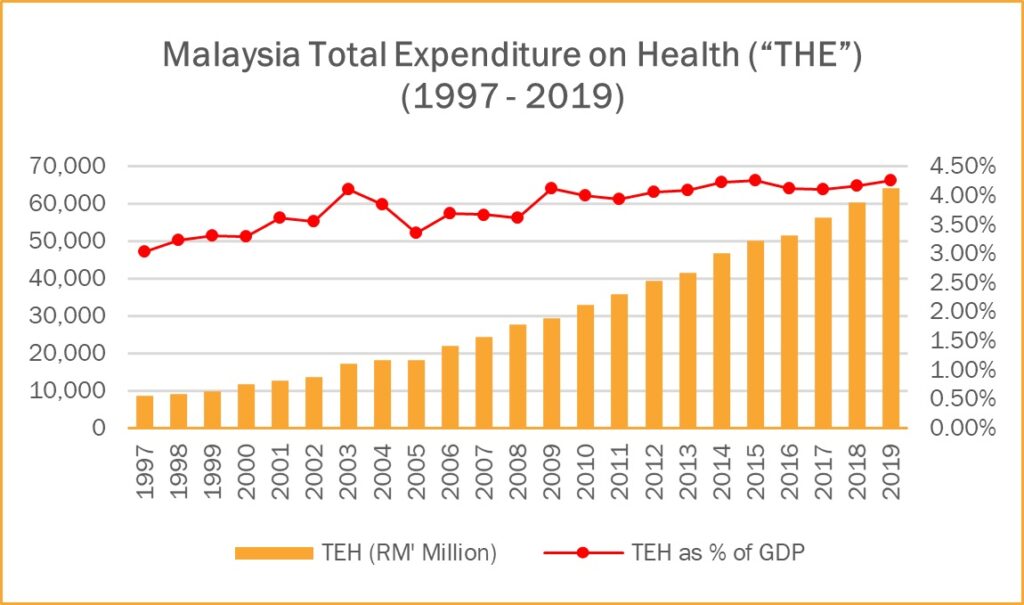
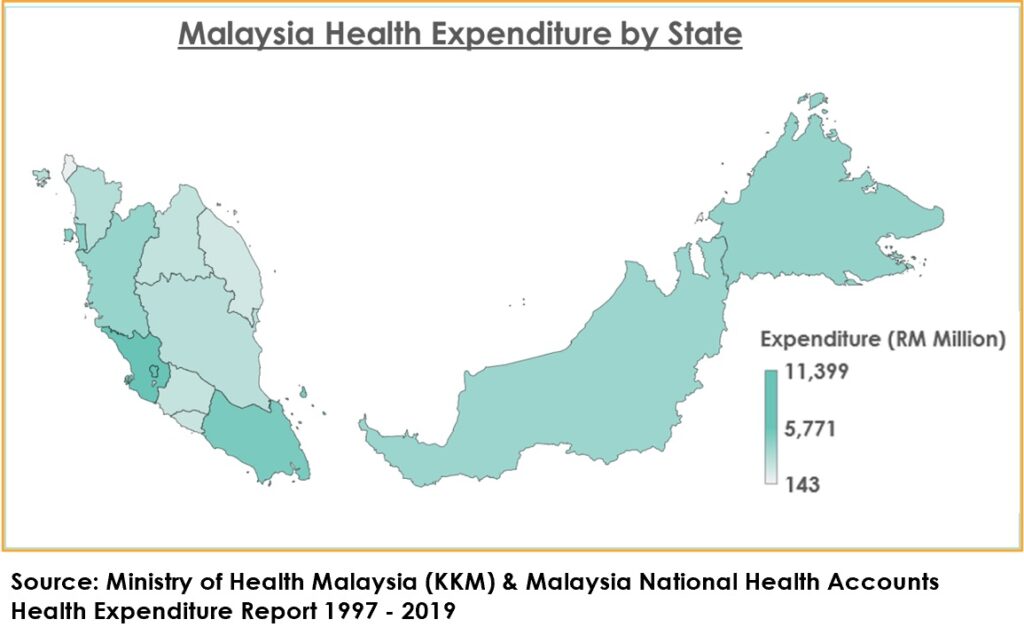
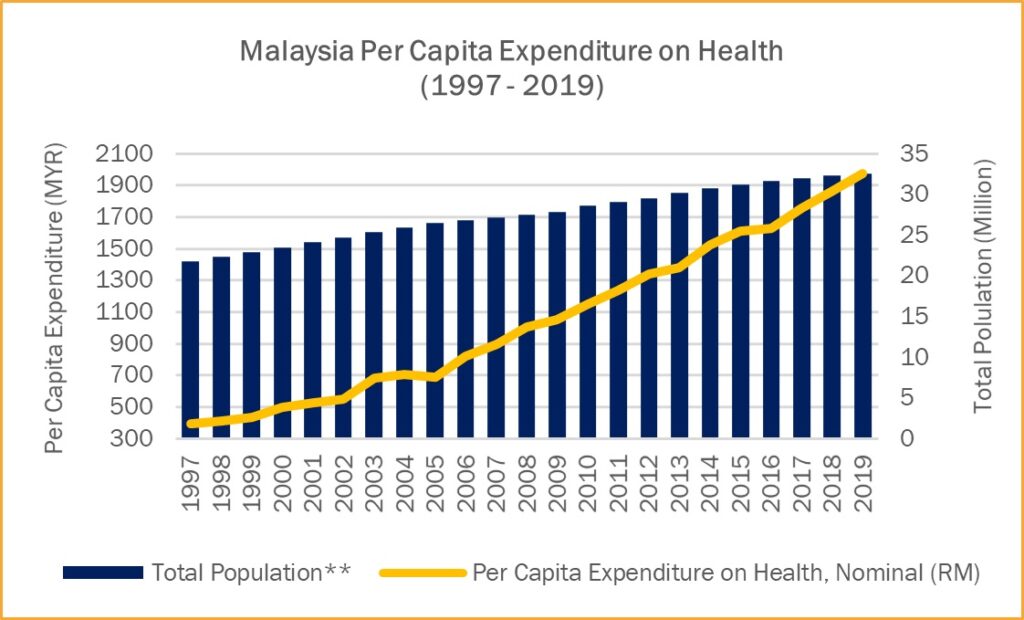
Elderly population aged 65 & above accounts for 7.0% of Malaysia’s total population and is projected to reach 14.5% by 2040. This, coupled with cultural and the increasingly stressful lifestyle is anticipated to increase demand for healthcare, especially in urban areas.
Furthermore, health consciousness and awareness level has also increased in tandem with the rise of Malaysia’s middle-income population.
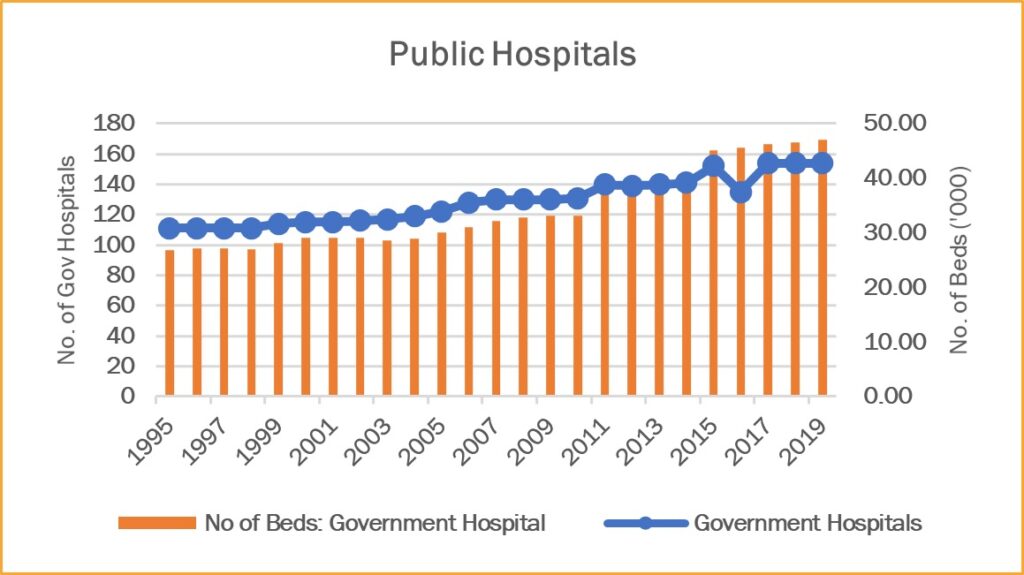
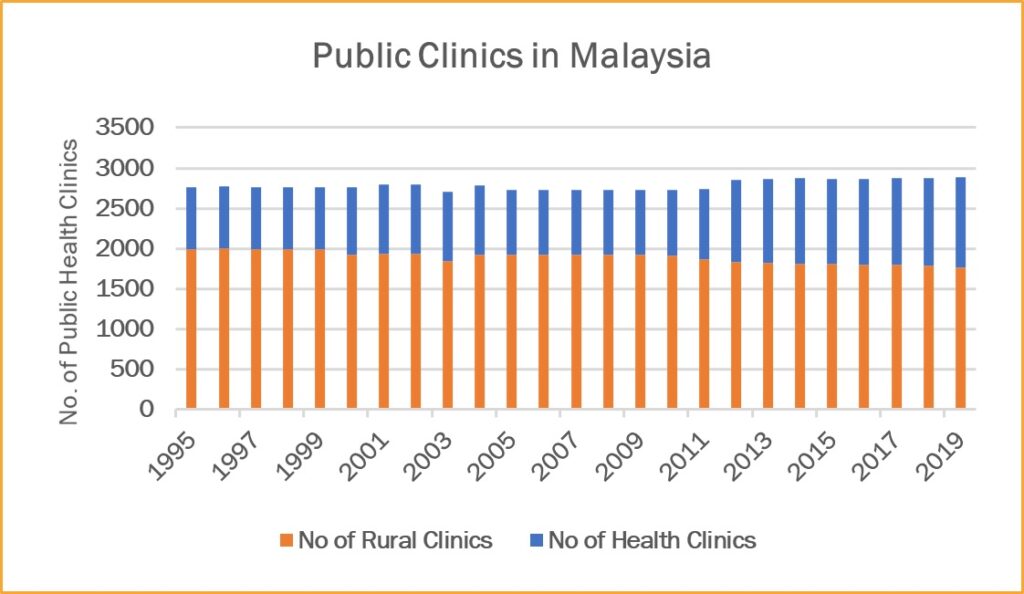
Public Healthcare: Legacy Issues & Brain drain
Like many developing nations, public healthcare is often marred by red tapes, overcapacity, inefficiencies.
- Overcrowded Public Hospitals
- Number of beds in public hospital spiked up since 2015 while number of hospitals stayed stagnant.
- Health Clinic Stagnations; Inaccessible to rural citizens
- The increments in public clinics are offset by closure of rural clinics over the years.
- Accessibility to public clinics has decreased, especially for Malaysians in rural areas.
- Systemic Issue vis-à-vis Job creation
- Medical graduates still struggle to obtain placement as a houseman (9-12months wait time) due to insufficient training hospitals. Brain drain ensues.
Private Healthcare: Conventional Mold at premium
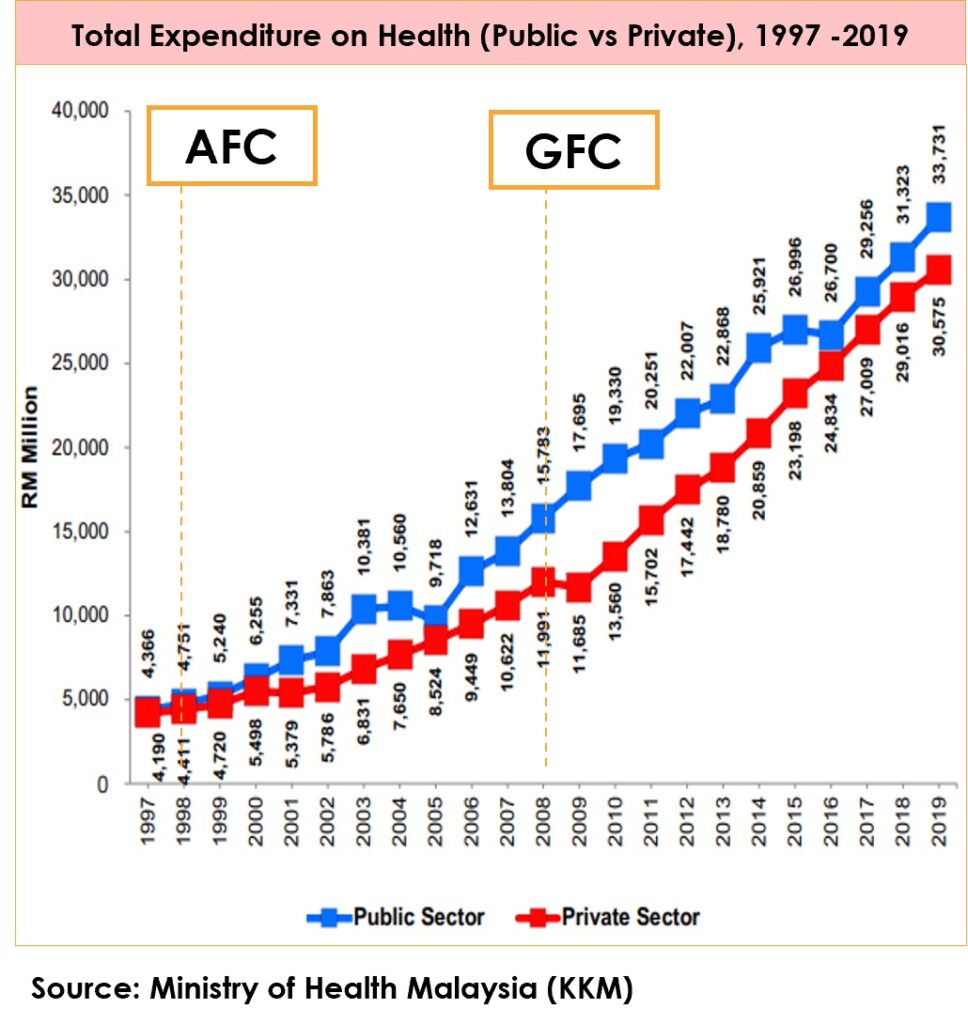
Private healthcare in Malaysia is essentially molded from its government-led public counterpart.
- Recent years saw increased traction in private healthcare, as Total Expenditure on Health (THE) for both private and public near convergence since 2016.
- Possibly due to factors such as cultural biased towards government institutions and/or the increase in disposable income.
- Profit driven and largely owned by corporates, innovations are often imported from developed markets and sold to Malaysians at premium.
Malaysia Healthcare Industry: Primed for Disruption
Both public and private healthcare are plagued by their own set of issues. Despite having the capacity to innovate, the focus on profit and cost effectiveness dilute the core function of these private healthcare providers – healing patients.
From the ancient Greeks who congregate in temples to heal their ailments to the invention of vaccine by Edward Jenner, modern healthcare encompasses wide range of products and services, from specialized to ancillary. Like Beam Micromobility who reshaped inner city travelling in Greater ASEAN, there are medical/health focused start-ups who will reshape Malaysia’s Healthcare Industry. Be it B2G or B2B2C, the inefficiencies in both our public and private healthcare system are sure to create opportunities.
Enter Healthtech
Healthtech can broadly be defined as application of technology centred around optimizing personal and preventive care. Not to be confused by medtech, a different vertical of digital healthcare that focuses on therapeutic technologies and medical devices that treat existing medical issues and diagnostic technologies that detect medical conditions.
McKinsey & Co categorized digital health technologies into five main categories: R&D, wellness and disease prevention, screening and diagnosis, care delivery, and finance and operations.
Notable Healthtech Start-ups Around the World

- Combats neurodegenerative disorders like Alzheimer’s by developing cutting-edge antibody therapies

- Cloud based medical billing and practice management software

Post Pandemic Recovery Starts with A Healthy Mental State

Being a part of the Short-Term Economic Recovery Plan (PENJANA) as announced in June 2020, the Dana Penjana Nasional (DPN) is focused in stimulating the post pandemic recovery through the investments in its 8 VC funds.
At the heart of the matter, we understand to aid recovery, we need to be holistic in our investment approach. Much has been talked about on the economic effects of the pandemic. It is evident and easily accessible through multiple media channels. Social effects, on the other hand, may have grazed news channels briefly but not much have been said about the aftermath of the pain and suffering caused by the pandemic and how it has affected the average Malaysians.
As of 29 November 2021, the Covidnow portal has reported over 2.6 million cases of Covid-19 in the country since the pandemic started and 30,303 deaths were recorded. Ministry of Health (MOH) also reported that from 1 January 2021 to 18 June 2021, 89.4 per cent (109,806 out of 122,328 calls) calls received by government helplines were related to mental health issues that required emotional and psychological support.
The loss of loved ones, new COVID-19 variants, loss of jobs and income, loss of a place of dependence, ongoing financial distress and family issues arising from long isolation are all factors that contributed to the rising number of mental health issues which were related to the pandemic. Watching Friends sitcom reruns (daily) will not help (trust me!). If not treated, the long-term effects of these mental health issues could be detrimental and possibly leading to death.
Realizing the importance of alleviating mental health issues as part of the pandemic recovery, the DPN has invested into two Malaysian healthtech start-ups in the hopes to make digital healthcare services accessible to the general public and create awareness on the importance of taking care of one’s mental health.
Naluri Hidup

The F&B market can be divided into two equal segments of food retail and food service. The global food retail segment has a market size of USD2.8 trillion, Deloitte has estimated that the global food service has a market size of USD3.1 trillion in 2019, with Asia Pacific representing almost half of the total market.
Problem Statement: Disorganised, High Wastage and Complex
F&B procurement has traditionally been very messy and disorganised. Restaurants are slow to digitalising their operations: they have no centralised system to track and organise their orders. Moreover, purchasing process in the F&B industry is still very manual, mostly performed via phone calls or messaging apps. As inventories are not tracked, the F&B industry has poor inventory management with outdated practices which lead to high wastage from over-ordering supplies. This leads to time wasted on manual data input as restaurants procure their supplies.
Thoughtfull

Established in 2018, ThoughtFull’s mission is to make access to mental healthcare accessible and affordable. ThoughtFull partners with corporates, insurers and healthcare providers to provide personalized preventive mental wellbeing solutions to individuals through its mobile app, ThoughtFullChat.
The company leverages behavioral science and evidence-based frameworks to empower users to build resilience on-the-go and professionals to build a digital practice. ThoughtFull is building the largest network of certified mental health professionals in the region and partnering with employers and insurers to bring preventive mental healthcare to all. The DPN had participated in Thoughtfull’s USD1.1million seed round, through it’s The Hive Southeast Asia Fund, a fund managed by DPN recipients, The Hive SEA and Tuas Capital Partners.
A study in 2018 reported that Malaysia had a significant deficit of psychiatrists and psychologists, with a ratio of 1.27 psychiatrists per 100 000 population. There were 410 registered psychiatrists working in private universities, private clinics, public universities and government hospitals. Malaysia needs at least 3,000 registered psychiatrists to meet the World Health Organization (WHO) recommendation of 10 psychiatrists per 100 000 population. Rapid urbanisation contributes to the uneven geographical distribution of doctors, with a decrease in numbers of psychiatrists in rural areas. There is a need for a uniform distribution of psychiatrists between all geographical locations within Malaysia and beyond.
As we move towards the digitalization of the psychiatrists and psychologist services, we hope this could bridge the gap between urban and rural areas whilst providing greater access to mental health services for Malaysians.

A Year in Review
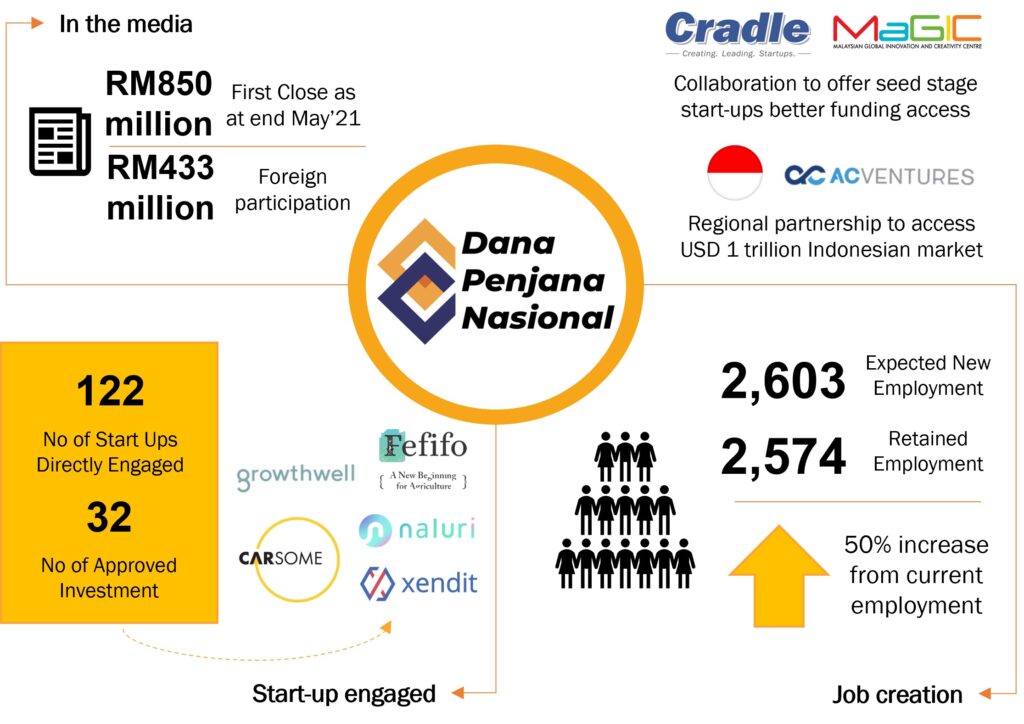
2021 Q3 Fundraising Activities
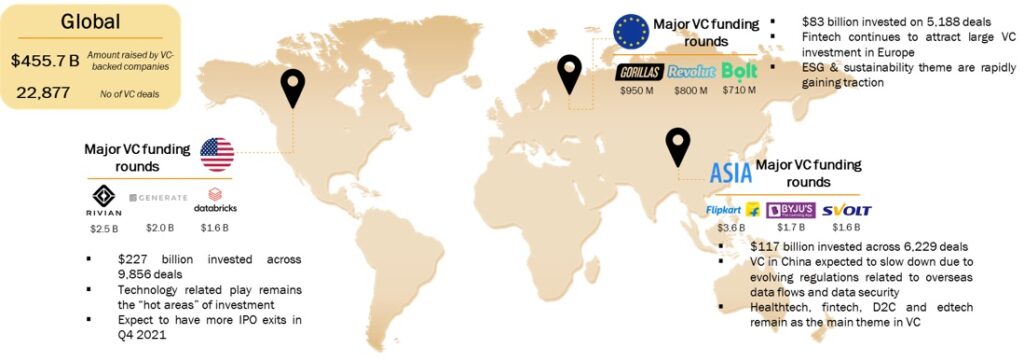
Venture Capital in Asia
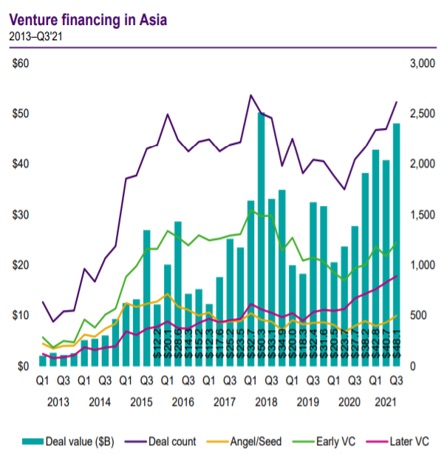
2021: 19 start-ups in ASEAN achieved unicorn status
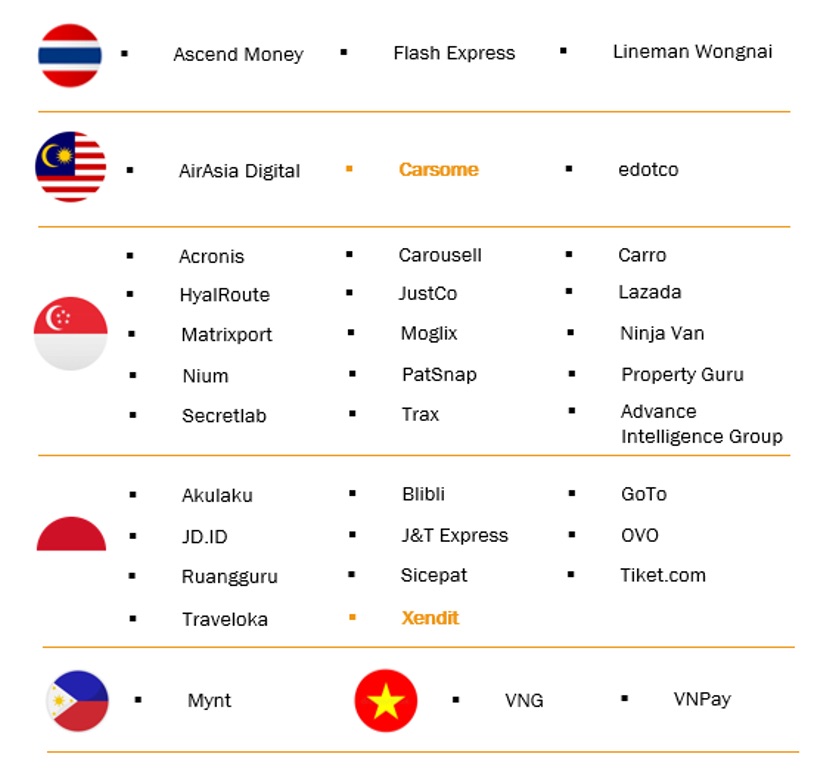
Source: Q3’21 Venture Pulse Report, Global trends, KPMG Global

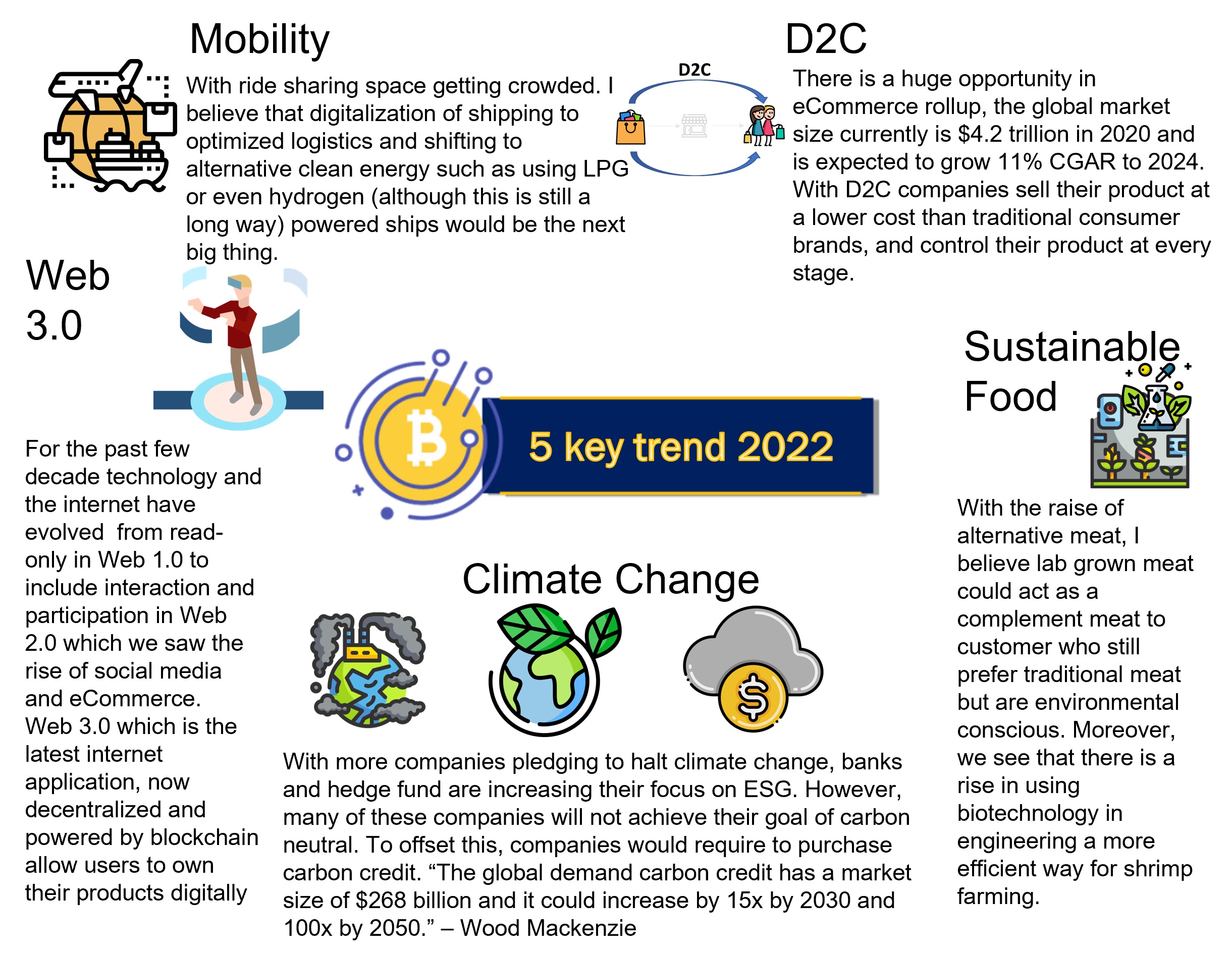
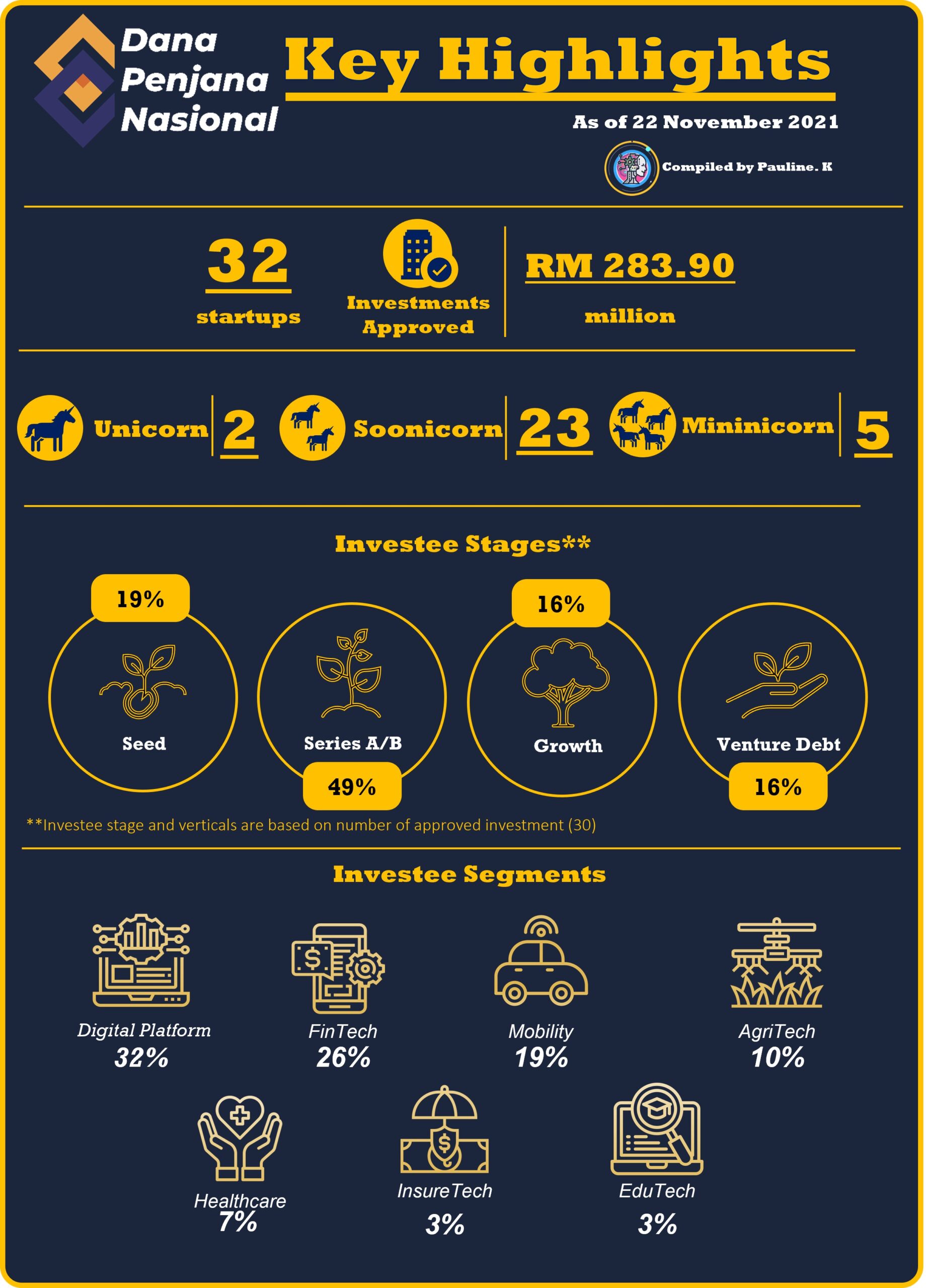
| DISCLOSURES AND DISCLAIMER |
This Newsletter is strictly informational and is issued Penjana Kapital Sdn Bhd (“PKSB”) on the basis that it is only for the information of the particular person to whom it was provided. This document may not be copied, reproduced, distributed or published by any recipient for any purpose unless Penjana Kapital Sdn Bhd’s prior written consent is obtained. This newsletter has been prepared for information purposes only and is not intended as an offer to sell or a solicitation to buy any securities, and/or any other product in Public or Private markets. Penjana Kapital Sdn Bhd is not making any recommendation to buy any securities or other product and the information provided should not be taken as investment advice.
It has been prepared without regard to the individual financial circumstances and objectives of persons who receive it. Penjana Kapital Sdn Bhd has no obligation to update its opinion or the information in this newsletter and Penjana Kapital Sdn Bhd recommends that you independently evaluate particular investments and strategies and seek the advice of a financial adviser prior to entering into any transaction. The appropriateness of a particular investment or strategy will depend on your individual circumstances and objectives. The information herein was obtained or derived from sources that Penjana Kapital Sdn Bhd believes are reliable, but while all reasonable care has been taken to ensure that stated facts are accurate and opinions fair and reasonable, we do not represent that it is accurate or complete and it should not be relied upon as such. All opinions and estimates included in this newsletter constitute our views as of this date and are subject to change without notice.
Penjana Kapital Sdn Bhd is not acting as your advisor and does not owe any fiduciary duties to you in connection with this newsletter and no reliance may be placed on Penjana Kapital Sdn Bhd for advice or recommendations of any sort. Nothing in this newsletter shall constitute legal, accounting or tax advice, or a representation that any transaction or investment is appropriate for you taking into account your investment objectives, financial situation and particular needs, or otherwise constitutes any such advice to you. Penjana Kapital Sdn Bhd makes no representations or warranties, express or implied, with respect to the accuracy of the information or fitness for any particular purpose and does not accept any liability (including but not limited to any direct, indirect or consequential losses, loss of profits and damages) for any use you or your advisors make of the contents of this newsletter or for any loss that may arise from the use of this newsletter or reliance by any person upon such information or opinions provided in the newsletter. This newsletter has been prepared by the analysts of Penjana Kapital Sdn Bhd. Facts and views presented in this newsletter may not reflect the views of or information known to other business units within Penjana Kapital Sdn Bhd. This information herein is not intended to constitute “research” as it is defined by applicable laws. This newsletter is not directed to or intended for distribution to or use by any person or entity who is a citizen or resident of or located in any locality, state, country or other jurisdiction where such distribution, publication, availability or use would be contrary to law or regulation. The information provided in this document has been obtained or derived from sources believed to be reliable. Penjana Kapital Sdn Bhd does not guarantee its accuracy or completeness and does not assume any liability for any loss that may result from the reliance by any person upon any such information or opinion. Such information or opinions are subject to change without notice, are for general information only and is not intended as an offer to sell or a recommendation/ solicitation to buy any securities, foreign exchange or other product.
